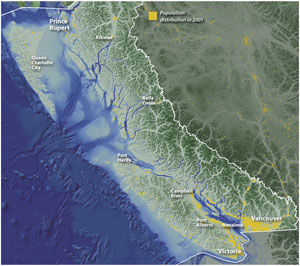

B.C. report paints dire climate picture
British Columbia’s Coastal Environment 2006
Executive Summary [pdf 36 KB]
Full Report [pdf 5.3 MB]
British Columbia’s Coastal Environment webpages
B.C. report paints dire climate picture
Nicholas Read, Victoria Times-Colonist, 15-Jul-2006
COMMENT: Better read this report quickly. It may not be many days or hours before it is "disappeared" from government websites.
B.C. report paints dire climate picture
Nicholas Read
CanWest News Service
Victoria Times-Colonist
Saturday, July 15, 2006
VANCOUVER -- Climate change in B.C. is expected to alter the province's hydroelectricity supply, affect the productivity of lakes, rivers and the ocean, change ecosystems and increase the risk of forest fires, pest outbreaks, flooding and extreme weather, according to a new government report.
The report, titled British Columbia's Coastal Environment: 2006, focuses on the part of the B.C. extending westward from the Coast Mountains, and includes the marine area within Canada's 322-kilometre limit. Among its grim conclusions:
- Five per cent of "rare and sensitive ecosystems" on eastern Vancouver Island have disappeared in the last 10 years, and could be gone for good in the next 20 years. The study focused on 412,000 hectares from north of Campbell River to Sooke and the Gulf Islands. At the beginning of the study in 1992, sensitive ecosystems made up 7.9 per cent of the study area. By 2002, that number had been reduced to 4.5 per cent. The report attributes most of this loss to logging and clearing, which accounted for 1,176 lost hectares of sensitive ecosystems.
- At least 629 species of alien plants are growing on the B.C. coast, and 65 per cent of these are firmly established.
- Forty-one species of vertebrates have been intentionally or accidentally introduced.
- The daily volume of sewage discharged into Georgia Basin rose more than 60 per cent between 1983 and 1999.
- The sea surface temperature has risen by as much as 1 C along the entire coast.
- Eighty-six B.C. species are listed as locally extinct, endangered or threatened, and of the 21 species known to be extinct, 15 used to occur on the coast.
- More than 13 per cent of salmonid populations in B.C. and the Yukon are either extinct or at high risk of extinction.
- Persistent contaminants, such as PCBs, dioxins and furans, continue to accumulate in animals near the top of the food chain. Resident orcas in B.C.'s southern waters are among the most contaminated marine mammals in the world.
The report was prepared over two years by the Ministry of the Environment in collaboration with Fisheries and Oceans Canada, the University of B.C. Fisheries Centre, the University of Victoria geography department and Environment Canada.
Linda Gilkeson, a ministry official who managed the research and writing of the report, said there is much to worry about: "The climate change implications are so big, so expensive and so here."
But the report also contained some positive news, including:
- Contamination cleanup has been completed at half the sites listed in the B.C. Contaminated Sites Registry.
- Concentrations of PCBs, dioxins, furans and other pesticides in the eggs of great blue herons have dropped markedly since 1980.
- Forty-nine per cent of managed salmon stocks are stable, increasing or well above target abundance.
© Times Colonist (Victoria) 2006
British Columbia's Coastal Environment: 2006
The coastal zone, where the land and Pacific Ocean meet, is one of the most diverse and productive environments in the world. For thousands of years people have lived on the British Columbia coast, depending on its rich resources.

Click on map for larger version.
How have we affected the coastal environment? What are we doing about it? What can YOU do about it?
To answer these questions a partnership of provincial and federal ministries and two universities began work in 2004 on a project to report on the state of British Columbia’s coastal environment. The results are presented here.
The coastal region spans the area from the top of the coast mountains, west to Canada’s 200-mile limit in the Pacific Ocean.
British Columbia’s Coastal Environment 2006
Executive Summary [pdf 36 KB]
Full Report [pdf 5.3 MB]
British Columbia’s Coastal Environment webpages
Use the links on the left-hand menu to navigate through the six main topics and associated indicators, as well as obtain the 2006 report.